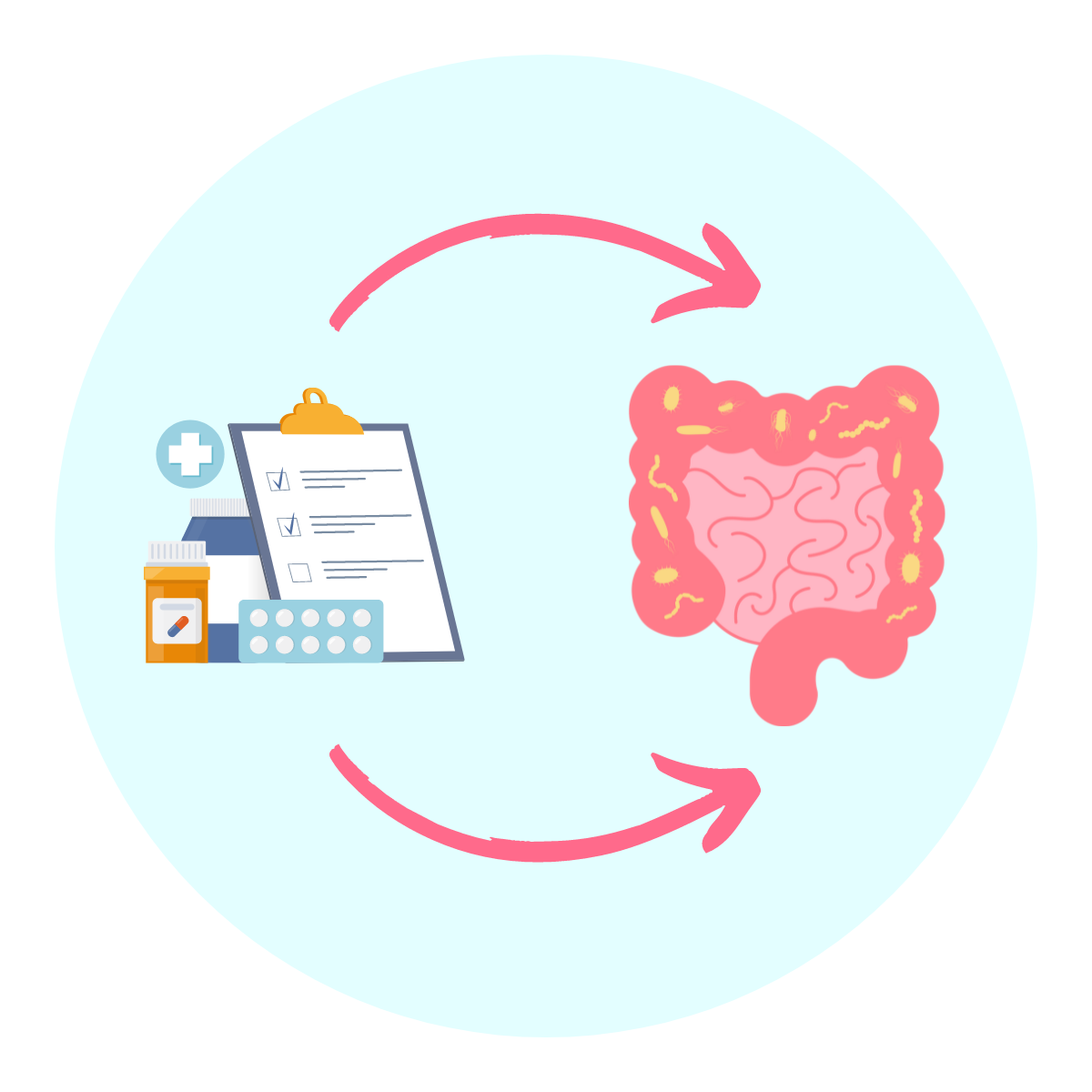Antibiotics, celebrated as miracle medications for their ability to treat bacterial infections, have undeniably transformed modern medicine. However, their widespread and sometimes indiscriminate use has led to unintended consequences, particularly concerning the delicate balance of the gut microbiome.
Antibiotics have a significant impact on the gut microbiome, which is a complex community of microorganisms present in the gut. One of the key associations between them lies in their mechanism of action. Antibiotics work by either killing bacteria (bactericidal) or inhibiting their growth (bacteriostatic). While their primary objective is to eliminate pathogenic bacteria causing infections, they are not selective and can affect a wide range of bacterial species, including those essential for maintaining a healthy gut. This can cause dramatic changes in the composition, diversity, and function of the gut microbiota.
Antibiotics have two distinct kinds of effects on the gut microbiome: direct and indirect. Direct effects refer to antibiotics’ immediate influence on bacterial populations in the gut. Antibiotics can reduce microbial diversity and affect the relative abundance of specific bacterial taxa. Broad-spectrum antibiotics, such as amoxicillin or ciprofloxacin, can influence a diverse variety of bacterial species, whereas narrow-spectrum antibiotics, such as vancomycin, may target specific kinds of bacteria.
Indirect effects of antibiotics on the gut microbiome stem from alterations in microbial metabolism and interactions within the ecosystem. Antibiotic-induced alterations in bacterial populations can impair symbiotic connections and cross-feeding interactions between microbial species. For example, the loss of particular bacterial taxa may impair the production of essential metabolites or nutrients, affecting the growth and survival of other microbes. This imbalance in microbial balance can cause dysbiosis.
Antibiotics have varying impacts on the gut microbiome based on the type of antibiotic used, the duration of treatment, and individual microbial composition. Broad-spectrum antibiotics, which target a diverse range of microorganisms, can cause more serious disruptions than narrow-spectrum antibiotics.
Anaerobic bacteria, which flourish in the gut’s oxygen-deprived environment, are particularly prone to antibiotic-induced disruptions. These bacteria are essential for intestinal health because they ferment dietary fibers and produce short-chain fatty acids (SCFAs) like butyrate. Anaerobic bacteria disruption can result in the expansion of pathogens such as Clostridium difficile, which can cause severe antibiotic-associated diarrhea. The inflammatory response caused by antibiotic-induced dysbiosis creates an environment rich in reactive oxygen and nitrogen species that certain bacteria, such as Escherichia coli and Salmonella, may utilize for anaerobic respiration. This allows them to outcompete beneficial bacteria and establish infections.
Furthermore, antibiotics can impair the anaerobic bacteria’s hypoxic barrier, resulting in enhanced gut oxygenation. This oxygen influx promotes the growth of aerobic and facultative anaerobic bacteria, altering the microbiome’s balance. Antibiotics inhibit bacterial signaling pathways that are required for host-microbiota interactions. Toll-like receptors (TLR) and nucleotide-binding oligomerization domain (NOD)-like receptors identify microbial components and control antimicrobial peptide production. Antibiotic-induced gut microbiome changes lower TLR and NOD signaling, resulting in decreased synthesis of antimicrobial peptides and poor host defense against infections. This imbalance of immune responses can make you more susceptible to infections and compromise immunological homeostasis.
Mitigating antibiotics’ adverse impacts on the gut microbiome is critical for retaining microbial diversity, maintaining immunological function, and avoiding associated health problems. Several measures can help to reduce these effects:
Probiotics: Probiotic supplements containing beneficial bacteria like Lactobacillus, Bifidobacterium, and Saccharomyces can help restore microbial balance disrupted by antibiotics. However, it is vital to select evidence-based strains and provide them at appropriate times during antibiotic therapy.
Prebiotics: Dietary fibers present in fruits, vegetables, whole grains, and legumes work as prebiotics by feeding beneficial bacteria in the gut. Consuming prebiotic-rich meals or supplements can aid in the healing of the gut bacteria following antibiotic therapy.
Synbiotics: By combining probiotics and prebiotics, synbiotic formulations can be more successful at promoting gut health. These products provide beneficial bacteria with the nutrients they require to survive, hence promoting microbial variety and resilience.
Fecal Microbiota Transplantation : It is the process of introducing feces from a healthy donor into the gut to restore microbial equilibrium. It is quite effective for treating recurrent Clostridium difficile infection, however it should only be done under medical supervision due to the risks involved.
Selective decontamination : It involves using narrow-spectrum antibiotics or other antimicrobial drugs to target particular microbes while avoiding disturbance to the gut microbiota. Healthcare specialists should guide this strategy depending on each patient’s specific needs.
Proper Antibiotic Use: Responsible antibiotic prescribing and management are critical for reducing negative effects on the gut microbes. Healthcare providers should prescribe antibiotics only when necessary, choose the most appropriate agents, and use the lowest effective dose for the shortest duration possible.
Dietary and lifestyle changes: Adopting a healthy lifestyle and eating habits can help improve gut health and resilience to antibiotics. Patients should eat a variety of fiber-rich meals, remain hydrated, exercise regularly, manage stress, and avoid excessive antibiotic use.
Post-Antibiotic Recovery: Following the conclusion of antibiotic treatment prescribed, patients should focus on supporting gut microbiome recovery. This could involve taking probiotics, prebiotics, and fermented foods, as well as gradually reintroducing fiber-rich meals and avoiding processed or inflammatory foods.
FURTHER READING :
- The varying effects of antibiotics on gut microbiota : https://tinyurl.com/4xxejvsf
- Facing a new challenge: the adverse effects of antibiotics on gut microbiota and host immunity : https://tinyurl.com/45vxthcf
- Antibiotics and the Human Gut Microbiome: Dysbioses and Accumulation of Resistances : https://tinyurl.com/5n6zds5y
- Effects of Antibiotics upon the Gut Microbiome: A Review of the Literature : https://tinyurl.com/2r77sdbw
- Association of gut dysbiosis with intestinal metabolites in response to antibiotic treatment : https://tinyurl.com/hewwazy5
- Effects of Antibiotic Treatment on Gut Microbiota and How to Overcome Its Negative Impacts on Human Health : https://tinyurl.com/452yfrn9
